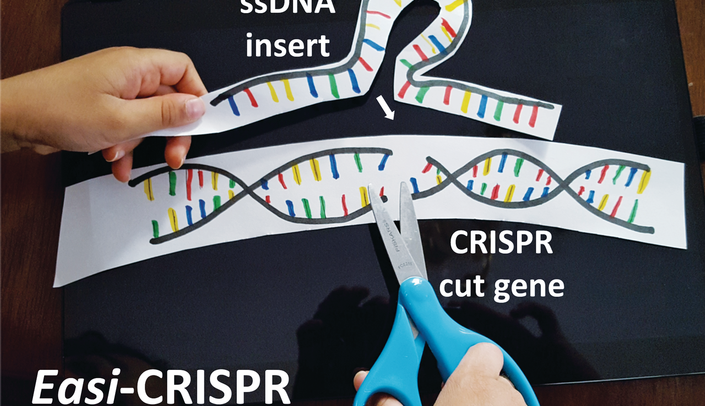A study published May 17 in the journal Genome Biology shows how highly popular, custom genetically engineered animal models are easily generated using a new, patent-pending technology called Easi (Efficient additions with ssDNA inserts)-CRISPR. Easi-CRISPR allows researchers to create these much-needed animal models at previously unheard of rates and significantly lower cost.
"With Easi-CRISPR, creating knock-in mice is as simple as using 'Find' and 'Edit' in Microsoft Word," said Paula Turpen, Ph.D., director for research resources at UNMC. Dr. Turpen likened previous genetic-engineering methods to reading through a manuscript and making changes with a manual typewriter and a bottle of liquid "Wite-Out."
Channabasavaiah Gurumurthy, Ph.D., M.V.S.C. (D.V.M.), associate professor of developmental neuroscience at UNMC's Munroe-Meyer Institute, led the Easi-CRISPR study.
Building off the CRISPR-Cas genome editing methods, Easi-CRISPR is the crucial next step in genome engineering to create designer animal models.
These models help scientists study the role of genes and mutations in human diseases, and explore the use of gene therapy and other potential treatments.
CRISPR was a groundbreaking advance, allowing scientists to "cut" individual genes from a genome as a replacement for creating "knockout" models. But, generating more complicated knock-in and conditional knockouts – which comprise more than 90 percent of animal models created – still proved inefficient, challenging and expensive.
Easi-CRISPR, by contrast, enables the insertion of long DNA sequences into CRISPR-cut genomes at efficiencies of up to 100 percent.
From left, Dr. Gurumurthy and his UNMC team, Rolen Quadros and Donald Harms
Dr. Gurumurthy said increased efficiencies are the result of inserting long single-stranded DNA, rather than double-stranded DNA. The idea came to his long-term collaborator, Masato Ohtsuka, Ph.D., of Japan's Tokai University, at a 2014 conference while the two scientists literally were scribbling on a napkin.
Two scientists not involved in the research praised the technology. Harvard geneticist George Church, Ph.D., said Easi-CRISPR shows much greater precision, and the method "looks like it lives up to its acronym, ‘Easi.’"
William Skarnes, Ph.D., director of cellular engineering for the Jackson Laboratory for Genomic Medicine in Farmington, Conn., said Easi-CRISPR is a significant advance in genome-editing technology. "With this tool, researchers can move beyond simple, crude knockouts to make much more sophisticated alleles (variant forms of a given gene) with nucleotide precision," he said.
Easi-CRISPR is the result of an international collaboration between seven institutions, headed by Drs. Gurumurthy and Ohtsuka, with Suzanne Mansour, Ph.D., of the University of Utah as a major collaborator. The collaboration includes Integrated DNA Technologies (IDT), a global leader in custom nucleic acid synthesis and genome editing products, based in Coralville, Iowa.
The research community has been very receptive and he has received multiple invitations to conduct keynote talks and workshops worldwide, Dr. Gurumurthy said. "Eight independent labs and counting have been able to replicate the study’s results."
Web extra
Read Dr. Gurumurthy’s journal article.
